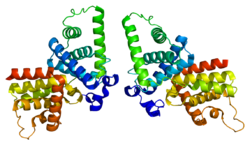サイクリンT2
(CCNT2から転送)
サイクリンT2(英: cyclin T2)は、ヒトではCCNT2遺伝子にコードされるタンパク質である[5][6][7]。
機能
編集CCNT2遺伝子にコードされるサイクリンT2タンパク質は、高度に保存されたサイクリンファミリーに属する。このファミリーのメンバーは、細胞周期を通じてそのタンパク質存在量に顕著な周期性がみられることで特徴づけられる。サイクリンはサイクリン依存性キナーゼ(CDK)の調節因子として機能する。サイクリンはそれぞれ異なる発現と分解のパターンを示し、有糸分裂の各イベントの時間的調整に寄与している。サイクリンT2とそのキナーゼパートナーであるCDK9は、転写伸長因子P-TEFbのサブユニットであることが知られている。このサイクリンT2を含むP-TEFb複合体はHIV-1のTatタンパク質と相互作用し、その負の調節因子として機能することが報告されている[7]。
相互作用
編集出典
編集- ^ a b c GRCh38: Ensembl release 89: ENSG00000082258 - Ensembl, May 2017
- ^ a b c GRCm38: Ensembl release 89: ENSMUSG00000026349 - Ensembl, May 2017
- ^ Human PubMed Reference:
- ^ Mouse PubMed Reference:
- ^ a b “Identification of multiple cyclin subunits of human P-TEFb”. Genes Dev. 12 (5): 755–62. (Apr 1998). doi:10.1101/gad.12.5.755. PMC 316581. PMID 9499409.
- ^ “The CDK9-associated cyclins T1 and T2 exert opposite effects on HIV-1 Tat activity”. AIDS 13 (12): 1453–9. (Nov 1999). doi:10.1097/00002030-199908200-00003. PMID 10465067.
- ^ a b “Entrez Gene: CCNT2 cyclin T2”. 2023年9月16日閲覧。
- ^ “Physical interaction between pRb and cdk9/cyclinT2 complex”. Oncogene 21 (26): 4158–65. (Jun 2002). doi:10.1038/sj.onc.1205511. PMID 12037672.
関連文献
編集- “[Problem of occupational disability hazards]”. Lebensversicher Med 28 (3): 76–7. (1976). PMID 9544.
- “Interactions between Tat and TAR and human immunodeficiency virus replication are facilitated by human cyclin T1 but not cyclins T2a or T2b”. Virology 255 (1): 182–9. (1999). doi:10.1006/viro.1998.9589. PMID 10049833.
- “Role of the human and murine cyclin T proteins in regulating HIV-1 tat-activation”. J. Mol. Biol. 288 (1): 57–69. (1999). doi:10.1006/jmbi.1999.2664. PMID 10329126.
- “Analysis of the effect of natural sequence variation in Tat and in cyclin T on the formation and RNA binding properties of Tat-cyclin T complexes”. J. Virol. 73 (7): 5777–86. (1999). doi:10.1128/JVI.73.7.5777-5786.1999. PMC 112638. PMID 10364329.
- “The Cdk9 and cyclin T subunits of TAK/P-TEFb localize to splicing factor-rich nuclear speckle regions”. J. Cell Sci. 114 (Pt 8): 1491–503. (2001). doi:10.1242/jcs.114.8.1491. PMID 11282025.
- “7SK small nuclear RNA binds to and inhibits the activity of CDK9/cyclin T complexes”. Nature 414 (6861): 322–5. (2001). Bibcode: 2001Natur.414..322N. doi:10.1038/35104581. PMID 11713533.
- “Isolation of SDS-stable complexes of the intermediate filament protein vimentin with repetitive, mobile, nuclear matrix attachment region, and mitochondrial DNA sequence elements from cultured mouse and human fibroblasts”. DNA Cell Biol. 20 (9): 531–54. (2001). doi:10.1089/104454901317094954. PMID 11747605.
- “Physical interaction between pRb and cdk9/cyclinT2 complex”. Oncogene 21 (26): 4158–65. (2002). doi:10.1038/sj.onc.1205511. PMID 12037672.
- “MAQ1 and 7SK RNA interact with CDK9/cyclin T complexes in a transcription-dependent manner”. Mol. Cell. Biol. 23 (14): 4859–69. (2003). doi:10.1128/MCB.23.14.4859-4869.2003. PMC 162212. PMID 12832472.
- “Large-scale characterization of HeLa cell nuclear phosphoproteins”. Proc. Natl. Acad. Sci. U.S.A. 101 (33): 12130–5. (2004). Bibcode: 2004PNAS..10112130B. doi:10.1073/pnas.0404720101. PMC 514446. PMID 15302935.
- “Transcriptional activity and substrate recognition of cyclin T2 from P-TEFb”. Gene 343 (1): 173–9. (2004). doi:10.1016/j.gene.2004.08.027. PMID 15563843.
- “The bromodomain protein Brd4 is a positive regulatory component of P-TEFb and stimulates RNA polymerase II-dependent transcription”. Mol. Cell 19 (4): 523–34. (2005). doi:10.1016/j.molcel.2005.06.027. PMID 16109376.
- “Pkn is a novel partner of cyclin T2a in muscle differentiation”. J. Cell. Physiol. 207 (1): 232–7. (2006). doi:10.1002/jcp.20566. PMID 16331689.
- “Abrogation of signal-dependent activation of the cdk9/cyclin T2a complex in human RD rhabdomyosarcoma cells”. Cell Death Differ. 14 (1): 192–5. (2007). doi:10.1038/sj.cdd.4402008. PMID 16841087.
- “Regulation of P-TEFb elongation complex activity by CDK9 acetylation”. Mol. Cell. Biol. 27 (13): 4641–51. (2007). doi:10.1128/MCB.00857-06. PMC 1951478. PMID 17452463.






